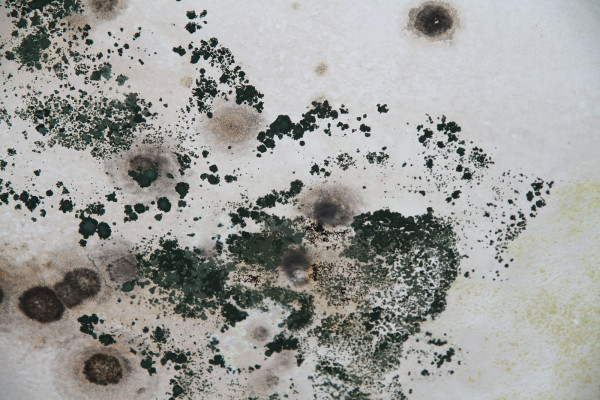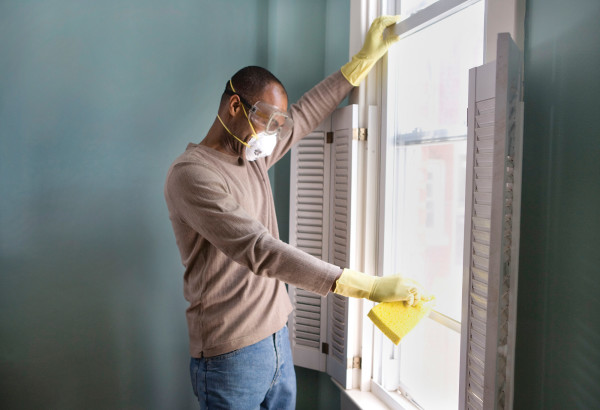
Whether your home is old or new, you’ve probably seen evidence of mold somewhere in or on the house. Mold can be found almost anywhere moisture is present, growing and proliferating on surfaces from grout to wallboard, wood paneling to carpet, and outdoors on siding or shingles. It’s most pernicious in areas that can’t be seen—in voids behind walls, inside HVAC ducts or cavities, or in attics or basements.
Molds reproduce by means of tiny invisible spores that float through the air. Astonishingly, there are 100,000 types and species of these spores. Some are harmless, and others can cause health problems. Allergenic molds, for instance, can create or trigger allergies in humans. Pathogenic molds are a threat to people with compromised immune systems—people undergoing chemotherapy, for example, or who have HIV or other immunological conditions.
The most feared molds are toxic molds. Fortunately, toxic molds are rare, usually occurring only in indoor environments that have been damaged, flooded, or closed up for long periods of time.
The two main types of toxic molds are Stacybotrys chartarum, better known as black mold, and Memnoniella echinata. (The main difference is how they grow. Black mold appears in splotches, while Memnoniella appears in chains.) Both grow on wet cellulose materials in hard-to-see or -reach places, such as the back sides of walls, wallpapers and textiles, crawl spaces and other enclosed cavities, and ventilation ducts. Toxic molds can cause severe health impacts, from poisonous toxins that can be fatal to animals, to bleeding in the lungs of very young children.
Small amounts of visible mold, like the kind that builds up in the shower, can be addressed by removing the moldy caulk and resealing the affected areas with new caulk. Afterwards, minimize obvious sources of moisture. If there’s no ventilation fan in the bathroom, for example, it would be prudent to add one. If the mold has penetrated the wallboard beneath—a common result in bathrooms and kitchens—a more serious repair is in order.
Other easy fixes include cleaning out the gutters, and caulking around leaking windows. Standing water in gutters holds moisture close to the house and can lead to leaks that may ultimately trickle into interior walls. Leaks around windows can compromise plaster and drywall. Since the water is coming in from outside, the mold may develop without visible evidence, although puffing or efflorescence in plaster or wallboard are telltale signs.
This should be obvious, but if the roof leaks, repair it. Look beyond finished rooms to the attic and basement or crawl space. Leaks in out-of-the-way places can go for years without notice, creating an optimum environment for mold.
If you do find visible mold, you can clean small areas yourself, provided the mold isn’t one of the two toxic varieties (both are black in appearance). On hard surfaces like wood, plaster, or wallboard, scrub the mold off with detergent and water. Let dry completely before painting.
If the mold has impregnated materials that are absorbent or porous, such as carpet, drapes, or upholstery, it may be impossible to clean it up yourself. For materials that are historic or have sentimental value, consult a qualified specialist in furniture or textile repair.
If the patch is greater than 10 square feet (more than 3′ by 3′), you suspect toxic mold, or the mold is hidden, call in a remediation professional. If the problem is in air handling vents or duct work, do not attempt to investigate it yourself and do not use the system until it’s been checked out. If old wallpaper is suspect, don’t peel it off unless you are wearing full protective gear. If there is mold growing on the underside of the paper, removing it can release a massive amount of spores into the air.
Because mold spores can aversely affect your health, wear gloves, goggles, and a mask when cleaning affected areas. Courtesy: Minnesota Department of Health
Reducing Moisture
Especially on hot or humid days, keep air moving throughout the house with fans, dehumidifiers, or air conditioning. Vent all combustion appliances to the outside. Washers, dryers, and cooking and heating stoves all produce water vapor and increase indoor humidity when not properly vented. Reduce moisture levels during and after showering in bathrooms by running the fan or opening windows. Use exhaust fans or open windows whenever cooking, running the dishwasher, or washing or drying clothing.
Mold and Biocides
Molds are living organisms, so they can be killed by biocides such as bleach. Generally, however, it’s not a good idea to remedy a mold problem by obliterating all the mold spores on the surface with a biocide, especially if the moisture problem hasn’t been addressed. If a moisture problem exists, mold will come back whether or not the area has been cleaned with bleach.
Dress for Mold Defense
If you are cleaning up an area of mold yourself, do not touch moldy areas with your bare hands, and avoid breathing in mold or mold spores.
• Wear an N-95 respirator, available at hardware stores or online. (Some resemble a paper dust mask with a nozzle on the front, others are made primarily of plastic or rubber and have removable cartridges that trap pollutants). Be sure the respirator fits tightly and securely to limit your exposure to airborne mold.
• Wear long gloves that extend to the middle of your forearm. Latex gloves are fine for cleaning with water and detergent, but if the remediation calls for chlorine bleach or another strong cleaning solution, use rubber, neoprene, nitrile, or other industrial gloves.
• Avoid getting mold spores in your eyes by wearing goggles, preferably the kind without respiration holes.







